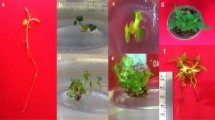Abstract
Saffron’s triploidy and male sterility result in generative limitations that highly impact its regeneration. Therefore, its natural reproduction is exclusively vegetative through progeny corms. The present work aims to improve in vitro saffron bud sprouting and adventitious shoot regeneration through direct organogenesis using different combinations of plant growth regulators, and then investigate novel conditions for mini-corm production. Murashige and Skoog medium (MS) containing 1 mg/L of 6-benzyl aminopurine (BAP) and α-naphthalene acetic acid (NAA) resulted in the highest bud sprouting rate (96.67%) and growth length (8.87 cm ± 0.27 cm). The best adventitious shoot initiation rate of 80% with 10.2 ± 0.23 shoots per explant was obtained using 0.5 mg/L NAA and 2.75 mg/L BAP. Remarkably, the critical step of mini-corm regeneration was improved using ½ MS, 6% sucrose, 1 mg/L NAA, and dark incubation. The corms produced weighed 7.9 ± 0.8 g, and 93.80% developed roots with an average of 14.9 ± 3.1 roots per corm. Improving the critical stages of saffron tissue culture is essential to meet the urgent need for its large-scale and low-cost regeneration.


Similar content being viewed by others
References
Agayev YMoghlu, Fernandez JA, Zarifi E (2009) Clonal selection of saffron (Crocus sativus L.): the first optimistic experimental results. Euphytica 169. https://doi.org/10.1007/s10681-009-9946-z
Ahmad M, Zaffar G, Mir SD et al (2011) Saffron (Crocus sativus L.) strategies for enhancing productivity. Res J Med Plant 5. https://doi.org/10.3923/rjmp.2011.630.649
Benjlil H, Elkassemi K, Aït Hamza M et al (2020) Plant-parasitic nematodes parasitizing saffron in Morocco: structuring drivers and biological risk identification. Appl Soil Ecol 147:103362. https://doi.org/10.1016/j.apsoil.2019.103362
Chib S, Thangaraj A, Kaul S et al (2020) Development of a system for efficient callus production, somatic embryogenesis and gene editing using CRISPR/Cas9 in Saffron (Crocus sativus L). Plant Methods 16. https://doi.org/10.1186/s13007-020-00589-2
Devi K, Sharma M, Singh M, Singh Ahuja P (2011) In vitro cormlet production and growth evaluation under greenhouse conditions in saffron (Crocus sativus L.) - a commercially important crop. Eng Life Sci 11. https://doi.org/10.1002/elsc.201000080
Devi K, Sharma M, Ahuja PS (2014) Direct somatic embryogenesis with high frequency plantlet regeneration and successive cormlet production in saffron (Crocus sativus L). South Afr J Bot 93. https://doi.org/10.1016/j.sajb.2014.04.006
Díaz-Vivancos P, Majourhat K, Fernández JA et al (2011) Study of the antioxidant enzymatic system during shoot development from cultured intercalar meristems of saffron. Plant Growth Regul 65. https://doi.org/10.1007/s10725-011-9581-2
Freytag C, Pabar SA, Demeter Z et al (2017) Production and characterization of tissue cultures of four Crocus species from the carpathian basin. Acta Biol Cracoviensia Ser Bot 59. https://doi.org/10.1515/abcsb-2017-0009
Hosseini A, Razavi BM, Hosseinzadeh H (2018) Pharmacokinetic Properties of Saffron and its active components. Eur. J. Drug Metab. Pharmacokinet. 43
Majourhat K, Fernández JA, Martínez-Gómez P, Piqueras A (2007) Enhanced plantlet regeneration from cultured meristems in sprouting buds of saffron corms. In: Acta Horticulturae
Mir JI, Ahmed N, Wani SH et al (2010) In vitro development of microcorms and stigma like structures in saffron (Crocus sativus L). Physiol Mol Biol Plants 16. https://doi.org/10.1007/s12298-010-0044-4
Mir I, Wajida NA S, et al (2014) In vitro development and regeneration of microcorms in saffron (Crocus sativus L). Afr J Biotechnol 13. https://doi.org/10.5897/ajb2013.12831
Mykhailenko O, Kovalyov V, Goryacha O et al (2019) Biologically active compounds and pharmacological activities of species of the genus Crocus: a review. Phytochemistry 162
Nemati Z, Blattner FR, Kerndorff H et al (2018) Phylogeny of the saffron-crocus species group, Crocus series Crocus. Mol Phylogenet Evol 127. https://doi.org/10.1016/j.ympev.2018.06.036
Parray JA, Kamili AN, Hamid R, Husaini AM (2012) In vitro cormlet production of saffron (Crocus sativus L. Kashmirianus) and their flowering response under greenhouse. GM Crops Food 3. https://doi.org/10.4161/gmcr.21365
Renau-Morata B, Moyá L, Nebauer SG et al (2013) The use of corms produced under storage at low temperatures as a source of explants for the in vitro propagation of saffron reduces contamination levels and increases multiplication rates. Ind Crops Prod 46. https://doi.org/10.1016/j.indcrop.2013.01.013
Rubio-Moraga A, Ahrazem O, Pérez-Clemente RM et al (2014) Apical dominance in saffron and the involvement of the branching enzymes CCD7 and CCD8 in the control of bud sprouting. BMC Plant Biol 14. https://doi.org/10.1186/1471-2229-14-171
Sharma KD, Rathour R, Sharma R et al (2008) In vitro cormlet development in Crocus sativus. Biol Plant 52. https://doi.org/10.1007/s10535-008-0136-y
Shokrpour M (2019) Saffron (Crocus sativus L.) breeding: Opportunities and challenges. Advances in plant breeding strategies. Industrial and Food Crops
Yasmin S, Nehvi FA (2013) Seasonal bud sprouting: a challenge for in vitro micropropagation in saffron. Vegetos 26. https://doi.org/10.5958/j.2229-4473.26.2.068.
Zeybek E, Önde S, Kaya Z (2012) Improved in vitro micropropagation method with adventitious corms and roots for endangered saffron. Cent Eur J Biol 7. https://doi.org/10.2478/s11535-011-0102-0
Acknowledgements
The authors appreciate Souktana Cooperative and Dar Azaafarane’s supply of plant materials.
Funding
This work is supported by the Hassan II Academy of Sciences and Technologies (SafranVal project) and the National Center for Scientific and Technical Research (PPR/2015/33 project), Morocco.
Author information
Authors and Affiliations
Corresponding author
Ethics declarations
Competing interests
None.
Additional information
Publisher’s Note
Springer Nature remains neutral with regard to jurisdictional claims in published maps and institutional affiliations.
Rights and permissions
Springer Nature or its licensor (e.g. a society or other partner) holds exclusive rights to this article under a publishing agreement with the author(s) or other rightsholder(s); author self-archiving of the accepted manuscript version of this article is solely governed by the terms of such publishing agreement and applicable law.
About this article
Cite this article
Lagram, K., El Merzougui, S., Boudadi, I. et al. In vitro shoot formation and enrooted mini-corm production by direct organogenesis in saffron (crocus sativus L.). Vegetos (2023). https://doi.org/10.1007/s42535-023-00639-9
Received:
Revised:
Accepted:
Published:
DOI: https://doi.org/10.1007/s42535-023-00639-9




